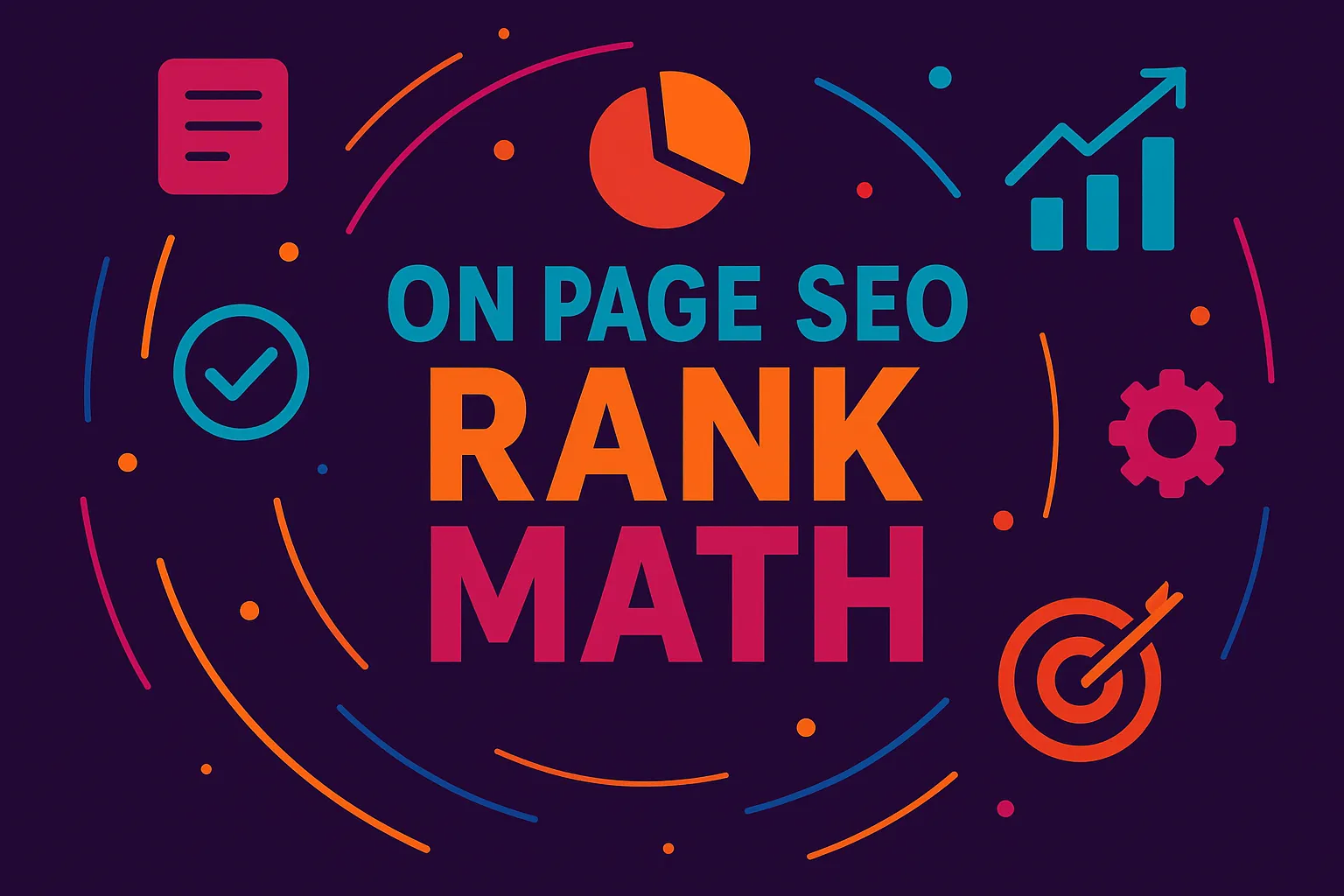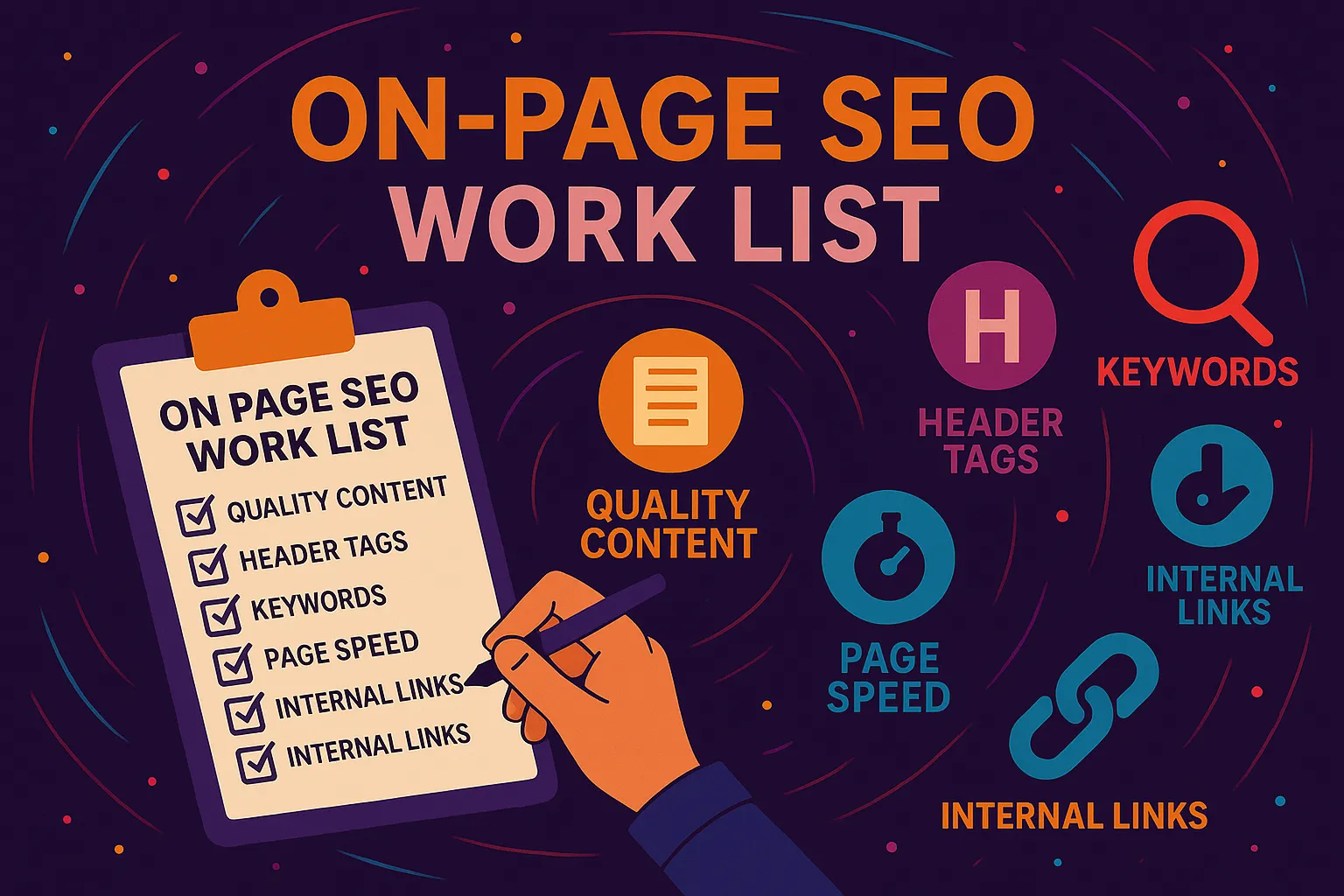What Is On Page SEO Rank Math?
Let’s keep this simple. On page SEO Rank Math refers to optimizing everything you can control on your website—titles, content, structure, links—using the Rank Math plugin. It’s like a smart co-pilot that keeps your site in perfect SEO shape while you focus on writing great content.
As the CEO of Vibe Branding, I’ve been hands-on with dozens of SEO tools over the last 10 years, and Rank Math has honestly become our go-to for all things on-page. It’s intuitive, powerful, and fast.
Whether we’re building from scratch or revamping a client’s site, Rank Math gives us the insight we need to compete on Google without bloated software or unnecessary guesswork.
TL;DR: What You’ll Learn in This Guide
- What on page SEO Rank Math is and how I use it at Vibe Branding
- How Rank Math compares to other SEO plugins like Yoast
- Key tips to optimize meta tags, URLs, schema, and content scoring
- How to set up Rank Math like a pro using our 10 years of digital marketing experience
- Mistakes to avoid, advanced tactics, and how to monitor your SEO performance
What Is Rank Math and How Does It Support On-Page SEO?
When we first installed Rank Math across all our internal projects and client sites at Vibe Branding, it changed the game. Before that, we used a mix of Yoast and custom scripts, but Rank Math brought everything together in one clean interface.
What I love most is how it supports every core aspect of on page SEO Rank Math in real time. As I’m writing this article in WordPress, Rank Math is sitting right next to me, scoring my SEO and giving live feedback.
It checks for title length, keyword usage, internal linking opportunities, and even schema markup. The Content AI feature—which I’ll go deeper into soon—literally gives smart suggestions based on the page’s topic.
This means we can optimize as we write. Rank Math helps my team avoid mistakes, meet Google’s standards, and publish pages that are more likely to rank.

How Does Rank Math Compare to Other SEO Plugins Like Yoast?
I’ve personally used Yoast for years, especially during the earlier days of WordPress SEO. But once Rank Math entered the picture, we began migrating our client base over.
Why? Rank Math does more for free.
Where Yoast locks features like multiple focus keywords or internal link suggestions behind a paywall, Rank Math includes them out of the box. The UI is also cleaner—easier for our newer team members and clients to understand without tons of training.
One example: Rank Math’s schema generator is just more flexible. I can add FAQ schema, product markup, or review stars with just a few clicks—no code needed.
In side-by-side tests, I’ve also noticed Rank Math tends to load faster and use fewer resources. In an agency like ours, performance matters.
We manage dozens of installs and speed adds up. If you’re serious about on page SEO Rank Math, I’d strongly recommend switching to it.
On-Page SEO Essentials: How Rank Math Helps You Optimize Key Elements
When we onboard a new client at Vibe Branding, one of our first moves is a deep on-page SEO audit. With Rank Math, that process is smoother than ever.
I can immediately see if the title tag is the right length, if meta descriptions are missing, or if the URL structure is a mess. The plugin highlights these issues like a highlighter in a textbook—clean and obvious.
It even reminds me if we forgot to add internal links or optimize image alt text. These may sound like small things, but trust me, they’re crucial. In competitive niches, one missed element can drop your ranking.
Rank Math helps us make sure every box is checked. When I explain on page SEO Rank Math to clients, I show them how the plugin practically walks you through optimization.
It’s like having an SEO coach in your editor 24/7.
Using Rank Math’s Content Analysis Tool for Maximum Impact
The Content Analysis Tool is one of my favorite features. It’s built right into every post and page, so as I’m writing this blog, it’s actively analyzing my content.
It looks at keyword usage, sentence length, passive voice, image count, and even whether I’ve used the keyword in subheadings. In our agency, we use this tool not just to clean up existing content but also to train our writers.
If a post doesn’t hit 80+ in the Rank Math score, it’s not ready. When we were using other SEO tools, we had to patch together insights from multiple places—now we get it in one view.
The “Fix with AI” button even gives you intelligent suggestions on how to improve weak areas. That’s a big time-saver when you’re editing dozens of posts a week.
On page SEO Rank Math is not just about getting green lights—it’s about learning what quality SEO looks like.

Keyword Recommendations and How to Use the Scoring System
I’ve worked with businesses that either overdo keywords or barely use them at all. Rank Math solves both problems.
When I type in a focus keyword, Rank Math immediately checks how well it’s integrated into the post. It scans the title, meta, URL, and content, and gives a score based on optimization strength.
More importantly, it offers suggestions—related keywords and variants—that help me naturally expand the topic without stuffing. If I’m writing a post about “email marketing tools,” it might suggest “automated email tools” or “email software for beginners.”
We use this feature heavily at Vibe Branding, especially when building pillar content. Plus, their scoring system is more nuanced than other tools.
A 100/100 isn’t always necessary, but hitting that green zone means you’re in solid shape. When it comes to mastering on page SEO Rank Math, learning how to read and use these scores is essential for consistency and success.
Schema Markup with Rank Math: A Hidden On-Page SEO Weapon
Before we started using Rank Math, schema markup was one of those things we had to manually build or use third-party plugins for. That meant more time, more bugs, and more chances for human error.
Rank Math changed that completely. I can now add schema to any post or page in seconds. Whether it’s a blog article, product review, FAQ section, or event listing, it’s all there and super customizable.
The built-in validator even lets us test it right away, which saves our developers a lot of time. Structured data is one of the most underrated on-page SEO elements.
It helps your content stand out in search results, improves click-through rates, and gives Google context about what your content is. At Vibe Branding, we use schema for almost every post now, especially if it’s cornerstone content.
It’s a major part of our on page SEO Rank Math process—and one that consistently brings results.
Meta Titles, Meta Descriptions, and Canonical Tags: Technical On-Page Wins
Getting technical SEO right is half the battle. I’ve seen websites rank low simply because they skipped something as basic as a compelling meta title or failed to set a canonical URL.
Rank Math prevents those slip-ups before they happen. It gives you dynamic variables to auto-fill meta fields at scale.
This is huge when managing blogs or ecommerce sites with hundreds of pages. One thing I appreciate most is the live preview—you can actually see what your title and description will look like in search results.
That visual feedback helps us fine-tune for clicks, not just rankings. The plugin also checks for duplicate titles and meta content. And canonical tags?
One-click and done. We’ve saved dozens of hours across client accounts using this feature alone.
For anyone serious about on page SEO Rank Math, getting these foundational elements right is non-negotiable—and Rank Math makes that easier than ever.

Understanding and Acting on the Rank Math SEO Score
Rank Math gives every page a score out of 100, and I’ll admit—it can feel a little like a game. But here’s the trick: it’s not about being perfect, it’s about being effective.
At Vibe Branding, we aim for 90+ on all major service and landing pages. Why?
Because we’ve tested it, and those scores usually correlate with better rankings. The score reflects how well your content follows SEO best practices—things like keyword placement, internal links, readability, and schema usage.
The tool tells you exactly what’s missing and how to fix it. Over time, it becomes second nature. I even train our interns using Rank Math because it teaches good SEO habits as you go.
If you’re managing a content team, this kind of standardized scoring system is invaluable. It brings clarity, focus, and repeatable results across your content strategy.
That’s why on page SEO Rank Math isn’t just a phrase—it’s our workflow.
Common On-Page SEO Mistakes (and How Rank Math Helps Avoid Them)
One of the biggest mistakes I’ve seen with clients—even big-budget brands—is keyword stuffing. They assume that using the keyword 20 times on a page means they’ll rank better.
In reality, that can hurt them. Rank Math flags overuse immediately.
Another issue? Missing alt tags on images.
You’d be surprised how often this gets ignored. Rank Math points it out before you publish.
Third, people often write meta descriptions that are either too short or too vague. The plugin alerts you and gives suggestions that actually improve click-through rate.
Also, many sites forget about heading structure—like using multiple H1s or skipping H2s entirely. Rank Math checks this too.
Lastly, duplicate content—especially for ecommerce sites—can kill rankings. Rank Math catches these issues with canonical tags and audits.
At Vibe Branding, we use these insights during every client audit. On page SEO Rank Math is powerful because it doesn’t just show you what’s right—it teaches you what’s wrong before it costs you traffic.
Advanced Rank Math Features to Boost On-Page SEO Performance
As someone who’s worked in digital marketing for over a decade, I’ve seen a lot of “all-in-one” tools fall short. Rank Math isn’t one of them.
Its advanced features actually do what they claim. One standout is the Redirection Manager.
Instead of installing another plugin, I can fix 404s and manage 301 redirects right inside the dashboard. That’s a big win for site health.
The 404 Monitor is another lifesaver. It tracks broken links so we can fix them fast—great for keeping bounce rates down.
There’s also Role Manager support, which we use to delegate SEO access without giving full admin rights. Content AI 2.0 has been huge for our team—it creates content outlines and FAQs with SERP intent in mind.
We even use Rank Math’s Instant Indexing for clients in high-velocity content spaces. When people ask me how to level up on page SEO Rank Math, I tell them: the tools are already built in—you just need to use them.
Monitoring and Improving SEO Performance with Rank Math Analytics
Rank Math doesn’t just help you optimize pages—it helps you monitor them after they go live. This is where the Analytics module comes in.
It pulls in data from Google Search Console and GA4 so we can see how each page is performing in real time. I check this dashboard weekly with my team.
We track impressions, average position, click-through rates, and focus keyword rankings. If we see a drop, we immediately go back to that post and re-optimize.
Rank Math even sends performance summaries, which we use in our client reports. Having all this data in one place saves us time and makes it easier to find patterns.
If you’re serious about scaling SEO, you need more than just a green light—you need insights. That’s what Rank Math Analytics delivers.
It turns on page SEO Rank Math from a one-time setup into an ongoing strategy that grows with your business.





